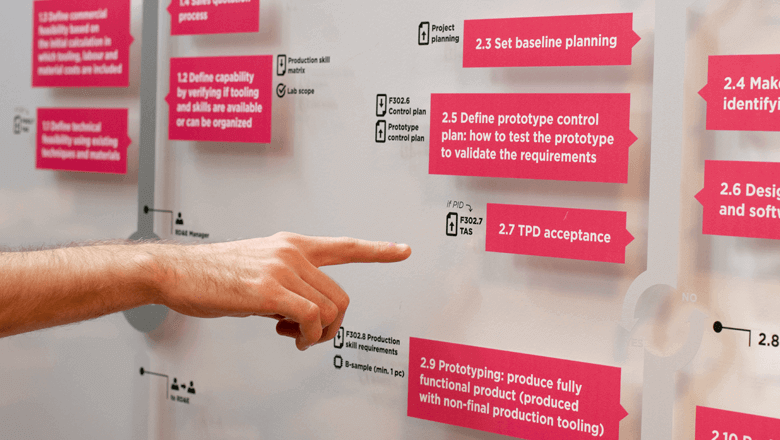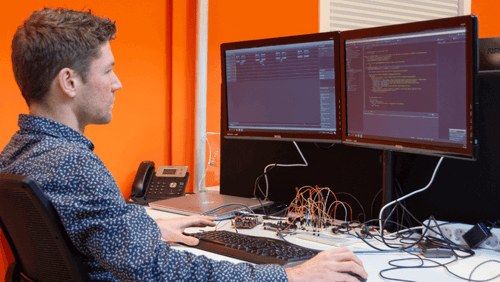Use sensors to cut your engineering costs

Custom or hybrid sensors are tailored to your specifications and needs. You might think that they would automatically be more expensive than standard solutions, but is that the case? A sensor only makes up part of the total cost of your machine. Engineering costs, quality processes, the supply chain and other associated factors also play a crucial role. Read how custom sensors can help you reduce the total cost of ownership of your machine.
The first thing to consider is what you need: a standard solution or a custom sensor. Sometimes, you have to make compromises in the design of your machine in all kinds of ways to make a component fit. How do you make the trade-off between custom and standard solutions?
Standard sensors versus custom sensors
As a buyer, you’re probably familiar with the opposing benefits of custom and standard solutions. In other words: the best technical solution for your machine can conflict with the desire to be independent of your suppliers. For this reason, OEMs often prefer a ready-made component, even if engineers have to make compromises in areas such as direct compatibility.
To make the right decision, you first need to be aware of the differences between standard and custom products.
Standard sensors
Standard sensors are catalogue products made by major sensor manufacturers. Manufacturers only develop these for high volume production. There must first be a general need for a certain type of sensor before manufacturers start making such products in large numbers. If you use one of these solutions, you’ll be bound by generic specifications that probably don’t match your specific wishes, as well as conditions in terms of batch size, packaging, etc.
Custom or hybrid sensors
Custom sensors are also known as hybrid sensors. These are often basic sensor components adapted to the design and specifications of your machine. Both the product and the supply chain processes around them are adapted to your needs. This includes aspects such as stock management, monitoring quality and customer-specific packaging. A custom solution means you don't have to compromise on the design of your machine.

"A catalogue product has certain fixed dimensions. If it doesn’t physically fit in the design of the application, the design of the machine is adapted to the sensor. In some situations, this can affect the performance of the finished product."
Minimize compromises
Fitting standard solutions in a new machine design often requires compromises to be made. Some of these compromises impact performance more than others. This depends on the specifications of your machine and the environment in which it’s used.
Striking a balance
Engineers integrating sensors have to strike the right balance between standard and custom products. How many compromises do you make on the machine side, and how many on the sensor side? This trade-off has to be carefully balanced. Decide what compromises you’re prepared to make. Remember that for some parts, a catalogue product is up to the job.
Reducing total costs with custom sensors
If you want to cut the design costs of your machine, you have to look beyond sensors. What engineers often overlook is that there are potential savings to be made on the elements around the component. Brackets, clamps or superfluous parts with which a sensor is attached, for example. In some cases, these peripheral items are no longer needed with a custom solution.
Even if a custom sensor costs more than a standard solution, the total cost of ownership of your product can be lower. Less has to be spent on elements around it because more modifications on the sensor side mean less modifications to the machine, or even none at all. Ultimately, the entire economic lifespan is what’s important.
Predictable quality and service life
A component’s service life depends on its quality in combination with environmental factors. These risks are already carefully considered in the case of custom products. Let’s look at an application in a milking parlor where the sensor is exposed to ammonia. The material of the housing must be able to withstand this aggressive atmosphere. The choice of material is also important for outdoor applications. For example, one plastic is more resistant to UV than the other.

Limit risks through development and production processes. Add extra checks to prevent errors. In this respect, it's very important that a problem is discovered in good time.
Optimal supply chain processes
Customization goes beyond the sensor itself, as the sensor specialist also tailors the associated supply chain process to your needs. Buyers can reap financial benefits from this. The methods below will help you optimize your supply chain.
- Appropriate packaging
Your sensor partner can help if specific packaging is important for your component. Kitting, for example, is useful if you want to send several components together in a single package to your end customers, especially if products have to be packaged in a cleanroom. Those without such special rooms in particular can cut costs here. - Just-in-time delivery
How many sensor solutions do you need per week? If you decide to go for customization, you can coordinate the purchasing structure to your production needs. You agree how many products you want to receive per week, which avoids the need for unnecessary volumes of stock. - External stock
Increasing the stock of your sensor solution reduces the delivery times of custom components. However, this inventory has a negative impact on your cash flow. Talk to the partner who develops your custom sensors, as they can often arrange to stock your components externally.
Managing risks during sensor integration
Whether you integrate standard or custom components, you’re almost always dealing with processes which involve people. The more human intervention in your production process, the greater the chance of errors.
Checks at the right moments
How can you reduce risks? Incorporate extra checks in your development and production process to prevent errors. In this respect, it's very important that a problem is discovered in good time, so think carefully about what check you perform at what moment. At the same time, keep an eye on the price-quality ratio.
Imagine that you insert contacts into connectors. If one of these contacts isn’t inserted deep enough into the connector, this connector will not lock. Including a check immediately after assembly enables you to detect in time when a contact has not been secured properly. A check at this stage significantly improves the PPM level.
Your predictable logistics chain starts here
Depending on your needs, a standard sensor or a custom sensor is selected. The modifications required to the design of your machine play a major role in deciding what’s best. Look beyond the price of the components.
Ultimately, what matters is the entire development and production process around the sensor, not just the sensor itself. This is where you can have an influence as a buyer, and reap advantages in terms of the supply chain. Our free e-book contains more tips and tricks on optimizing your supply chain.
Download the e-book, and you too can become an expert in this area.



